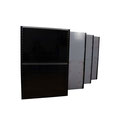Rhizobox Systems for Root and Rhizosphere Studies
Different rhizobox designs and sizes are available to study roots, rhizosphere and bulk soil processes under controlled conditions. VSI Rhizoboxes are durable and fully customizable.
Rhizobox Systems for Root and Soil Monitoring
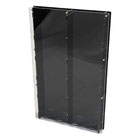
VSI Rhizoboxes. Vienna Scientific is a world leader in commercial rhizobox systems - used globally by a wide range of universities, research organisations and companies. The rhizoboxes
- are available online in three easy-to-order standard rhizobox configurations (A5 - A3 letter size, 3 cm deep) OR can be fully customized (see pdf configuration form below) to meet your research/educational goals,
- hold independently removable front and rear panels and flat surfaces (recessed screws) for easy imaging and manipulation, and
- are cost effective (in production and shipping), easy to assemble and disassemble (for thorough cleaning and storage) see FAQ for Rhizobox assembly instructions), and very durable (by using spacers instead of tapped threat holes), and
A wide range of matched accessories (racks, light shielding panels, manipulation stands) and rhizobox imaging platforms is available for implementing successful manual or automated experimental setups. Classic rhizoboxes with "tapped threat holes" in the side walls remain available. Please fill out a configuration form for custom rhizobox designs and/or contact us to discuss your unique rhizobox designs. Standardized rhizobox sizes (letter sizes A3 to A5) are available in the rhizobox online shop for customers within the EU.
Rhizobox - Features
- Ideal for replicated root, rhizosphere and soil studies ex situ
- Standard and custom dimensions (X x Y x Z) - small to large
- Durable with external spacers/screws to reduce screw hole wear
- Small storage volume, easy to assemble/disassemble
Optional
- Wide range of rhizobox accessories: Fitting racks, shading panels, storage boxes, etc.
- Split rhizoboxes, with user defined compartments
- Spare parts (to replace scratched panels, etc.) and exactly the same models (to extend experiments, etc.) available for years to come
- Matching rhizobox respiration chambers
| References | VSI Rhizoboxes | OPEN |
|
||
Custom Rhizobox designs (and accessories) can be configured using the Config. Form (pdf), please add it to your email as an attachment. Standard Rhizoboxes / Split- & Access. are available in the rhizobox online shop (EU).
Custom-Made Rhizobox Designs - Made to Fit Your Research Goals
The Rhizobox designs shown above (as well as other options) can be configured using the Rhizobox Configuration Form (pdf, above). Please have a look at Rhizonboxes (for water sampling) or Rhizotrons ("ultra-large Rhizoboxes") for special purpose boxes.
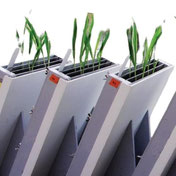
The VSI Rhizobox system can, however, be completely modified to meet your goals - see the configuration form, the Rhizobox image gallery (above) and/or some recent publications on rhizobox designs for ideas - or just ask us to develop a technical solution that fits your ideas.
For example, splitting the root compartment ("splitboxes") is a cost-effective way to double the number of replicates or treatments. Double split boxes allow the installation of permeable nets, e.g. creating mycorrhizal hyphae and root compartments. SplitRoot boxes allow for splitroot experiments, etc. As the screw holes for the (independently removable) front and backplates are cut directly into the side walls ("tapped holes") in classical rhizo-box designs, these holes in the plastic can wear out due to use/misuse (especially dirt, overtightening). The standard VSI Rhizobox design avoids this source of failure by attaching screws to sturdy, corrosion-resistant metal spacers located adjacent to the inner chamber - making filling easier and extending service life. "Classic" designs with tapped threat holes are still available for special applications, e.g. easily fitting respiration chambers on top of rhizoboxes. In any case, the flat surfaces of our root boxes (countersunk screws) allow for space optimised placement (back-to-back) and facilitate imaging by flatbed scanners. Angled rhizobox racks (40° - 45°, or custom angle), holding five rhizoboxes each (or custom numbers), are available in several configurations. Cost-effective shading panels protect the root systems from light. Root cooling boxes for root system temperature control are currently tested. See RhizoNboxes if soil pore water sampling / manipulation is part of your research, and hydroponic RootRoxes if you need a watertight system. Finally, the VSI Rhizobox design, with external spacers and cutouts for easy assembly, allows boxes to be shipped in a much smaller volume, massively reducing shipping costs.
Test your Custom Designs: Rhizobox Configurator
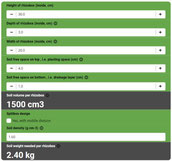
Wondering how much soil and rooting space will be available in your custom Rhizobox? How it depends on the size of the planting compartment and the thickness of the drainage layer or a split box design? Will the rooting volume be sufficient for the expected plant size? The Rhizobox Calculator (2023) makes it easy to determine the impact of specific rhizobox designs.
Rhizo-box Shipment & Assembly
Most of our Rhizoboxes (but "classic" designs with threaded holes) are shipped unassembled to allow for lower shipping costs. Read more about the fast DIY Rhizobox assembly.
Consider: Expected Plant Biomass When Planning your Rhizobox Study - Pot-Size effects
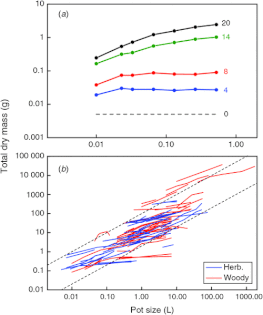
The majority of controlled experiments in plant sciences use plants grown in some container or pot - or rhizobox. Porter et al. (2012) conducted a meta-analysis on the effect of pot size on growth and underlying variables. On average, a doubling of the pot size increased biomass production by 43%. The appropriate rhizotron / rhizobox size will thus depend on the size of the plants growing in them. The meta-analysis of Porter and colleagues (2012) suggested that an appropriate pot size is one in which the plant biomass does not exceed 1 g per Liter - while current research often exceeds that threshold.
- Researchers thus need to carefully consider the rhizobox size applied in their experiments, as (too) small root boxes may change experimental results and defy the purpose of the study. Continue reading
-
See Porter et al. (2012) for details. However, Mašková & Klimeš (2020) found that proportional investment of plants into root biomass was similar in usual pots and in rhizoboxes. The pattern was stable across nutrition treatments and across species. Thus, if the rhizobox size is selected according to the estimated biomass at time of harvest, the geometric shape / form of the root box may have a limited effect on the experimental results. However, shallow- and deep-rooting species may still respond differently to the actual geometry of pots / rhizoboxes given the same volume (von Felten & Schmid 2008). In addition, lateral root system expansion can be limited by too narrow rhizoboxes, and too shallow rhizoboxes may hamper root systems depth development - roots "curling" at the bottom (i.e. drainage layer) of the rhizobox - hampering both growth analysis and interpretation of results incl. biomass depth stratification. Use a semiautomatic root washer to efficiently wash roots sampled from rhizobox experiments for biomass and morphological analysis. In any case, the hight of the soil column is also an important factor in determining the water content and its distribution within pots and therefore both the water potential and oxygen availability (Passioura 2006). Using the slim Bluetooth drill and drop probes in larger (thicker) rhizoboxes can help to understand the soil moisture distribution along the soil profile.
In sum, selecting appropriate rhizobox dimensions is key for obtaining most relevant results - we are thus happy to discuss species, water, temperature, and experimental period etc. before your order. Test your Rhizobox size fpor potential growth effects in our Rhizobox configurator tool.
Please see the brief articles on temperature effects on root growth and development and light effects on roots. In brief, many studies keep roots at the same temperature as shoots and/or illuminated, with consequences for results. See the article on rhizobox inclination angle on root visibility. In brief, the soil filling procedure and angled positioning of rhizoboxes during root system development influences the degree of roots visible at transparent rhizobox front panels.
| References | Rhizoboxes for Root Phenotyping, Plant and Soil Studies | OPEN |
|
||
Rhizobox Racks & Light Shielding Panels are made to hold Rhizoboxes at an angle - facilitating root growth along the transparent surface - and to keep the root s dark - types matching all rhizobox designs available.
For experiments with flooded plants, roots and soil - rice to natural wetlands - consider the Hydroponic Rootboxes.
Consider large, mobile Rhizotrons (i.e. ultra-large rhizoboxes) as mesocosms and/or for large-scale greenhouse experimentation. Rhizontrons follow different design and construction principles compared to Rhizoboxes.






























